The OnePlus 3T Review
by Brandon Chester on November 28, 2016 10:30 AM EST- Posted in
- Smartphones
- OnePlus
- OnePlus 3T
System Performance
One of the key internal changes that the OnePlus 3T brings to the table is a move from Snapdragon 820 to 821. At a high level, Snapdragon 821 is very similar to 820, and in the case of the OnePlus 3T it's really differentiated by its higher peak frequencies for the CPU and the GPU. Both have four of Qualcomm's Kryo cores in a 2 + 2 cluster configuration, and both use Qualcomm's Adreno 530 GPU. In the OnePlus 3 the performance cluster on the CPU had a peak frequency of 2.15GHz, which is brought up to 2.35GHz on the OnePlus 3T. On paper, this gives a performance improvement of roughly 10%, which is also what Qualcomm states in their marketing materials.
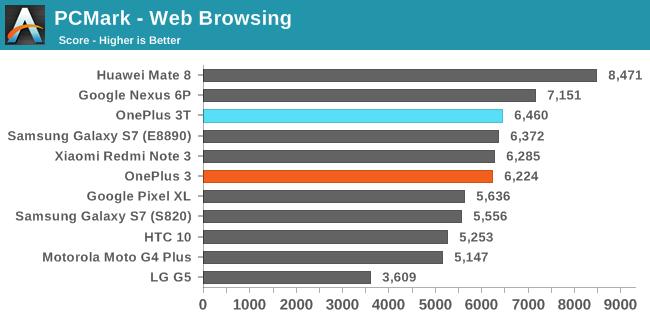
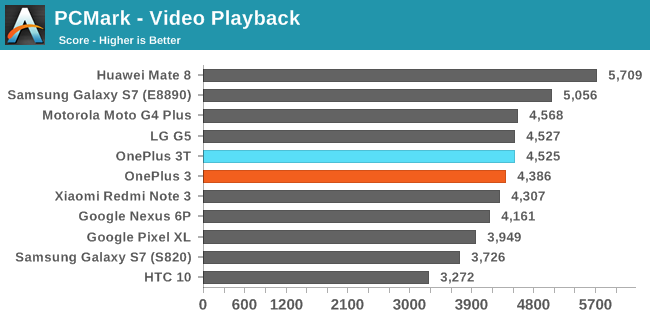
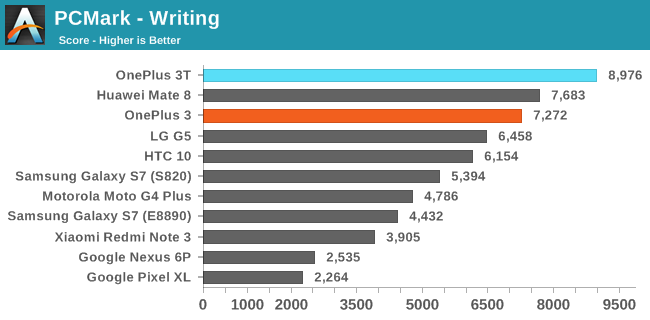


PCMark is a test that the OnePlus 3 performed exceptionally well in. This was due not only to the use of Snapdragon 820, but to software optimizations that OnePlus had made to the OS and the Android Runtime as well. The OnePlus 3T continues this trend, and provides performance improvements across the board. The writing and photo editing tests are the most interesting of the group, as these are tests where software optimizations helped the OnePlus 3 to pull ahead of other competing devices, and the OnePlus 3T pulls ahead even further. It bests the Huawei Mate 8 in the writing test to become the fastest device on record, and the photo editing test improves over the OnePlus 3 which was still the fastest device in the test up until now.
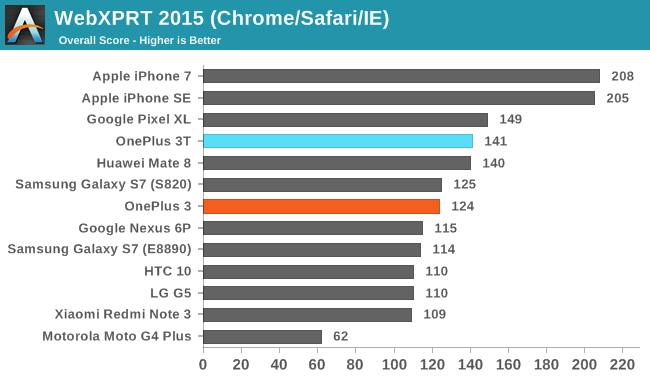
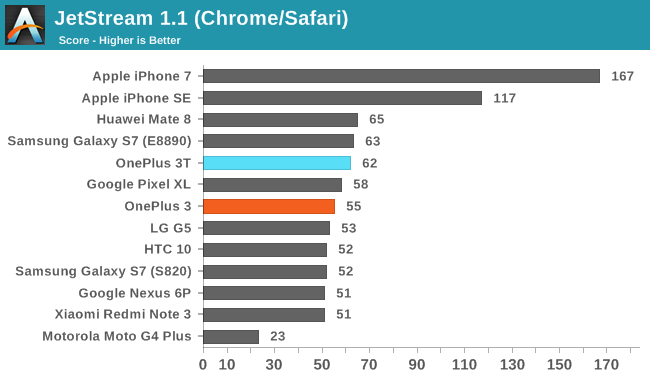
The OnePlus 3T's JavaScript performance benefits from improvements that Google has made in Chrome 54, as well as the increase in peak CPU frequency compared to the OnePlus 3. In the interest of having a fair comparison, I've updated the OnePlus 3's results using the latest version of Chrome so it can also take advantage of optimizations that have been made.
Kraken and WebXPRT 2015 both demonstrate the OnePlus 3T's improved JavaScript performance. The gap is actually a bit larger than one might expect from a 10% increase in CPU frequency, and this could simply be the result of other changes made to the operating system in the newer version of OxygenOS, or changes to the DVFS settings that have been made alongside the change in SoC. Jetstream shows a smaller improvement, but it's in line with what you'd expect to see from the CPU bump.
Ultimately, Snapdragon 821 doesn't come with any mind-blowing performance improvements for CPU-bound applications, but the update does keep OnePlus on par with the competition, and allows them to take advantage of improvements in efficiency and errata fixes in addition to a modest performance uplift. Certain parts of the PCMark test also indicate that the 3T comes with additional improvements at the software level, which will hopefully make their way to the OnePlus 3 with the next major update to OxygenOS, but for now are something you only get on the OnePlus 3T.


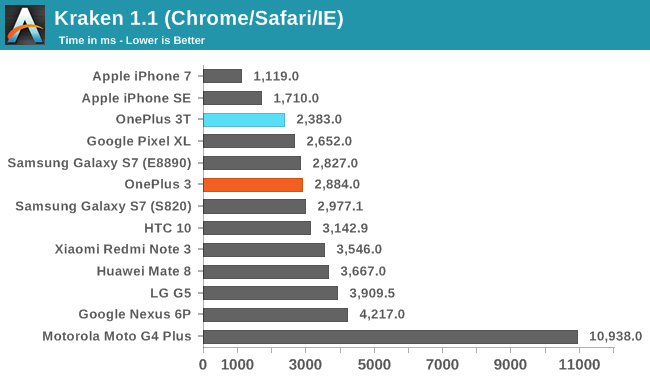








104 Comments
View All Comments
mortimerr - Monday, November 28, 2016 - link
Very few people, especially here, would voluntarily want to use whatever custom OS ZTE uses on the Axon 7, and even though ZTE is finally giving the appropriate data needed to get sound working with CM, it's still very early nightlies with numerous bugs you'd have to contend with.Where it's a completely different world with OP. And that's even if you decide not to use OxygenOS.
ToTTenTranz - Monday, November 28, 2016 - link
And the Axon 7 has a 1440p 5.5" AMOLED screen. And a dedicated DAC for reproducing 24/32bit audio sources, and amplified dual front-facing speakers.And it's allegedly one of the first few devices to support Daydream along with the Pixel phones.
If only ZTE would send review copies to anandtech...
bananaforscale - Tuesday, November 29, 2016 - link
Having a dedicated DAC for 24/32 bit sources is waste. You won't hear the difference and anyway you can simply add zeros to get the maximum word length.rocketman122 - Tuesday, November 29, 2016 - link
Yep. Id take the zte way before taking this opo 3 terrible. Oneplus support is crap just as much. So pay less and get morebananaforscale - Tuesday, November 29, 2016 - link
Don't count Beats phones as a value-add unless you have no idea what music should sound like.kubina - Friday, December 2, 2016 - link
No it's not :)The Oneplus 3T is not only best vaue-for-money phone, it's actual best phone on market. 3T is fater than iPhone 7Plus or Pixel XL. Have bigger battery and excellent almost pure OS.
Only feature where is Pixel (I'm not, if iPhone also) slightly better is Camera. But for this incremental uplift, I'm not willing to give twice more money.
Especially, Oneplus have better design, is thinner, have much better body-to screen-ratio and is lighter.
ZTE is typical phone , who looks good on paper, but the User experience is not so good :) Not is about paper specifications :)
negusp - Monday, December 5, 2016 - link
Eh, no. The Axon 7 is cheaper and has all-round better specs, and has official CyanogenMod support.Kepe - Monday, November 28, 2016 - link
3D Mark Slingshot physics and overall test results between the OnePlus 3 and the OnePlus 3T seem to be flipped.zeeBomb - Monday, November 28, 2016 - link
Aint that unexpected...OnePlus going for UFS 2.1 and F2Fs out of the box does make a huge difference in real world usage. Does that mean we'll not see much development with the original OP3?Here's a video where the iPhone 7 lost to the OP3 in some basic tests: https://www.youtube.com/shared?ci=4Z3QV1JMykQ
zeeBomb - Monday, November 28, 2016 - link
I wish this had the updated Sony IMX398 sensor. That would have been amazing. Maybe for the c4 I guess.